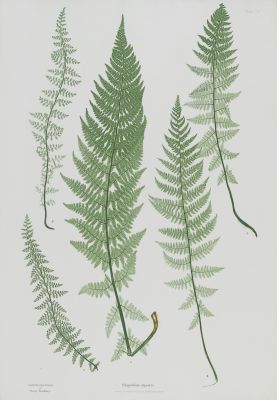
Title
“Lastrea Filix-mas incisa.” plate XVArtist
Bradbury, Henry (British, 1831-1860)Publication
The Ferns of Great Britain and IrelandDate
1855Process
Nature PrintAtelier
Bradbury, HenryImage Size
55.0 x 37.0 cm
A beautiful nature-printed plate from Moore’s The Ferns of Great Britain and Ireland.
From the preface… A draughtsman can do no more than to delineate a part of what he sees, and whether he sees correctly what he delineates, will at all times be a matter of doubt, especially where, as in natural history, accuracy is indispensable. To express such facts with the necessary accuracy, the art of a Talbot or a Daguerre, was insufficient, nor could they be represented pictorially until NATURE-PRINTING was brought to its present state of perfection.
Moore’s important work on nature printing was one of the first of the genre printed in England. The beautifully executed plates were produced under the direction of Henry Bradbury, England’s first nature printer, and are considered to be among the finest pieces of nature printing ever completed. The plates were produced …by passing the plant, under pressure, between a plate of soft lead from which an electrotype could be made. As a result, they recorded the smallest details of flowers and the finest vein structure of leaves.
Henry Bradbury, whose father was of the publishing house Bradbury & Evans, studied at the Imperial Printing Office in Vienna in 1852. His interest in printing extended to the production of bank notes and to the history of printing. While in Vienna he learned nature printing and thought so highly of the process that he subsequently tried to claim both England’s precedence in patenting the process, and his own patent on improvements to it. Although Bradbury thought Auer went too far when he wrote that the process was superior to photography, Bradbury made claims for it, as Auer did, in the kind of language used by early promoters of photography to assert that it enabled nature to draw itself. The nature-print process, Bradbury claimed ‘causes as it were the objects to engrave themselves by pressure‘. Bradbury went further than this, however, stating that the nature-printed products were so truthful that only a close inspection reveals the fact of their being copies, and so distinctly sensible to even touch are the impressions, that it is difficult to persuade those unacquainted with the manipulation, that they are an emanation of the printing-press. Others, including botanists and lace manufacturers, thought the process better than any previous method for reproducing the complex patterns of their objects of study or commerce.
Auer presented some samples of nature-printed lace to the Austrian chamber of commerce: History of Photography – The Nature Print and Photography in the 1850s [1]
Reproduced / Exhibited
DiNoto, Andrea, and David Winter. The Pressed Plant. New York: Stewart, Tabori & Chang, 2000. p. 110 (alt)
https://sflac.net/paper-conservation/nature-prints/
References
[1] Hume, Naomi. The Nature Print and Photography in the 1850s, History of Photography Volume 35, 2011
Welsbach, L. A. (1853). The discovery of the natural printing process, an invention for creating by means of the original itself…. Vienna: Imperial Court and Gov. Print. Off.
https://goo.gl/jUPNR8 retrieved on July 4th, 2018.
Reeds, K. M. (2006). “Leonardo da Vinci and Botanical Illustration: Drawing, Nature Printing, and Printing circa 1500." pp 205-237, in Visualizing Medieval Medicine and Natural History, 1200–1550, ed. Jean A. Givens, Karen M. Reeds, Alain Touwaide. (AVISTA Studies in the History of Medieval Technology, Science and Art, pp. 205-237). Vermont, VT: Ashgate.
Cave, R. (2010). Impressions of nature: A history of nature printing. London: The British Library.
